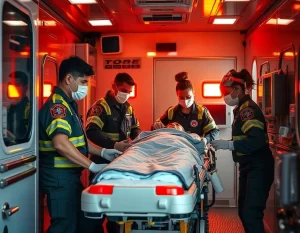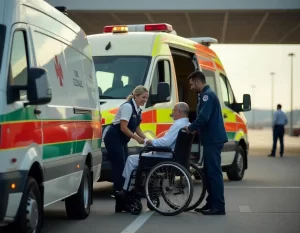 Careers
Contact
Book Now
Careers
Contact
Book Now
×
When looking at ambulance services, it is important to understand the differences. While all ambulances look the same a white siren, red and blue lights, an engine and a roof with ambulatory access ports — each service has its own goals and objectives. Ambulance services aim to respond to calls for medical assistance within a certain distance of their headquarters or base. This distance can range from four to 20 miles depending on the type of emergency call. Some ambulance services are more mobile than others. For example, they will have fewer ambulances that can be dispatched from different cities or towns instead of having only one main base in which all ambulances can be dispatched from.
The BLS Transportation Service helps people who are critically ill or have a mental health issue. It does not provide emergency medical services. First responders, like paramedics and firefighters, call this service in an emergency. The person who is being helped may be in the emergency room, intensive care unit (ICU) or another facility that can provide specialized care. Some of the services that this service provides include:
The sticker price for a BLS Transportation Service is $80 for one ambulance and $160 for five ambulances. This price includes the vehicle, driver, radio communications, medications, training and other equipment. The actual cost of providing the service will depend on the distance traveled, traffic conditions and other factors. Some ambulance services charge a monthly fee for the service. These fees are charged based on how often the service is used. Some of these fees are:
The four-staffed System II system is the standard in most ambulatory aid services. The Suhler-Fleischer system is used by the Life Support Ambulance Service in some areas. The Bauer system is used by the BLSES Transit Service. The Strom system is used by the Strom BLS Transport Service in the borough of Staten Island, where there is no hospital.
Some ambulance services operate a twenty four hour emergency service that responds to all calls. These services are sometimes known as saturation services. These services are not recommended for regular use. Some ambulance services also use a selective use fleet of off-duty police and fire vehicles to provide a mobile command post during disasters. These units are known as “BLSU” (Basic Life Support Unit) units. The Selective Use Fleet is managed by the New York City Fire Services Department (FDNY).
Schedule BLS Transport Services!
Book a reliable, safe, and comfortable BLS transport service today for you or your loved one. Quick and easy scheduling options available!
| Service type | Estimated Cost | Inclusions |
|---|---|---|
| Single Ambulance | $80 | Vehicle, driver, equipment |
| Five Ambulances | $160 | Fleet service, radio communications |
| Monthly Subscription | Varies | Based on service frequency |
There are a number of ways to find out about an ambulance service. One way is to call the service and ask for the latest status reports on nearby emergency calls. When you call the emergency number for an ambulance service, be prepared to give your name, address, emergency medical conditions and other information about the patient. You can also visit the emergency website for each service to get information on the service and times, as well as a list of nearby hospitals. You can also check out the social media pages of each service to get updates on your community’s emergency needs.
The Basic Life Support Service (BLSS) is one of the many emergency medical services (EMS) offered in New York. The service primarily serves as a backup to hospital emergency departments (EDs) in case a patient needs a more special care. As with most emergency services, the level of service provided by different ambulance companies will vary based on the distance the patient is expected to travel and how important the patient’s location is to the service. For example, a small town with a rural setting may only have one hospital and may not be necessary served by an ambulance service if the patient lives nearby the hospital. On the other hand, a city with a large population may not have an adequate response time to patients who call in sick from work and can’t be reached at home. Some ambulance services provide 24/7 coverage while others only operate during normal business hours. The type of service you choose will depend on the distance traveled and the time of the call.
A Basic Life Support (BLS) ambulance, like those operated by Infina Health, provides non-invasive medical care such as oxygen therapy, patient monitoring, and CPR. In contrast, Advanced Life Support (ALS) ambulances are equipped with advanced medical equipment like defibrillators, IV therapy, and ventilators, making them suitable for critical emergencies.
Infina Health’s BLS ambulances are ideal for stable patients who require medical transport but do not need advanced medical interventions. This includes non-emergency hospital transfers, post-surgical transport, and routine medical visits.
Unlike taxis or ride-sharing services, Infina Health’s BLS ambulances are staffed with trained EMTs and equipped with medical essentials like oxygen and automated external defibrillators (AEDs). This ensures patient safety during transport.
Yes! Infina Health’s BLS ambulances are staffed with certified EMTs who can provide CPR, oxygen administration, and basic wound care to stabilize patients until they reach a medical facility.
While NEMT services focus on wheelchair and stretcher transport without medical supervision, Infina Health’s BLS ambulances offer basic medical monitoring and trained EMTs, ensuring a higher level of care.
Infina Health is committed to safe, reliable, and professional BLS transport with well-equipped vehicles, trained medical staff, and a patient-first approach. Whether it’s a hospital transfer or a medical appointment, we ensure a smooth and secure ride.

Publish Date: April 15, 2025 How to Ensure Patient Safety and Care in Critical Care Transport Critical care transport involves the safe and effective transfer...
Read More...
Medical transportation companies have become an integral part of the healthcare system, providing essential services for patients who require assistance in traveling to and from...
Read More...
ALS Ambulance Service has reduced the time it takes to transport patients from hospitals to homes and care facilities. They also decrease the number of...
Read More...Infina Health has been providing transportation services to the residents of Pennsylvania for over 70 years. Our mission is to ensure the comfort of our passengers.
© 2025 Infina Health. All Rights Reserved.